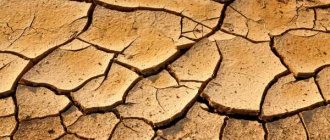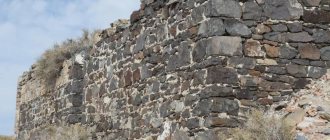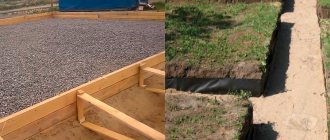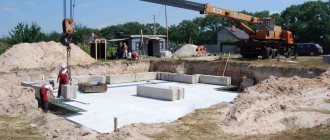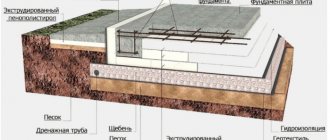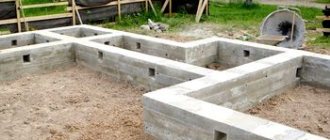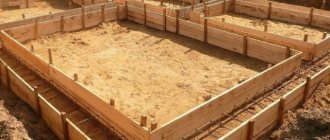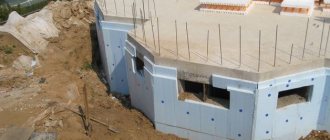A cushion under a strip foundation is a layer of a certain thickness of sand, gravel or crushed stone, designed to evenly distribute the weight load of a building structure on the ground. Not so long ago, regulatory documentation and technical literature on construction clearly required the presence of a cushion under the strip foundation of any structure.
However, the development of modern monolithic construction technologies and the use of chemical additives that increase the moisture resistance of concrete have created the prerequisites for revising the concept of mandatory addition of materials under the concrete base of a building structure.
How to properly make a pillow for a strip foundation: structure and dimensions, stages of work.
Scheme of pouring a monolithic foundation. The main parameters of the strip foundation technology are:
- Depth . This value depends on the weight of the building, as well as on the freezing of the soil in the area.
- Width . Depends on the material and width of the walls and should be at least equal to . but it is better if it exceeds the width of the walls by 10-15 cm .
After calculating the size of the required foundation, you should decide on the size of the cushion under it. The base performs several functions :
- Levels the surface . on which the foundation will be laid. This is more important if concrete blocks are used. There are no voids left under them and they rest on the ground their entire surface. In case of pouring a strip foundation. alignment less .
- Ensures uniform distribution of soil loads from the foundation.
- There is another important function that the pillow performs: it combats moisture in the soil and its impact on the entire structure due to seasonal temperature changes.
Note! If you remove heaving soil and replace it with non-heaving soil . this will significantly reduce the impact on the foundation when water freezes in winter.
Simple deformation of the base.
The soil will put pressure on the side walls of the foundation, pushing it upward, and the values of the buoyancy force can reach 5 - 7 tons per 1 m² of the base of the house. This is especially dangerous for timber or frame buildings that have little dead weight. Stone buildings, due to their mass, can compensate for lateral forces acting on the foundation.
protect yourself from heaving by placing a cushion under the foundation, replacing heaving soil with non-heaving soil. The same applies to backfill - the use of non-expanding soil will reduce the effect of tangential loads.
FL thickness
Usually the cushions have a uniform thickness, but sometimes the top surface may be sloping or stepped. The shape of the pillow in plan will depend on the nature of the applied load and the permissible load-bearing capacity of the underlying layers. And the thickness should be sufficient to distribute the load along the shape in plan. As a rule, pillows are reinforced on all structures. At the same time, reinforcement allows you to create higher loads and build smaller supports that require less excavation and use less concrete.
Pillow design and dimensions.
The average thickness of a sand cushion is considered to be 60 cm . It can vary in one direction or another depending on the type of soil. Severely heaving soils may require increasing this value to 80 centimeters or more. You can often find a recommendation that the thickness of the cushion should be 3 times the width of the foundation.
Foundation pillows.
The width of the pillow should protrude beyond the dimensions of the foundation by 15 - 20 cm in each direction. In the event that a basement is planned. then the sand cushion should be arranged not only under the foundation, but also under the entire area of the house.
The concrete floor of the basement is subject to the same loads, which means it also needs to be protected from the effects of the soil due to temperature fluctuations.
In the event that the soil is very heaving . A sand-crushed stone cushion is used, in which sand occupies 40% of the volume.
For laying, it is necessary to use pre-moistened sand, which will improve compaction . You can moisten it after laying sand in the trench, but do this only if the soil is not prone to erosion.
Important! It is advisable to use geotextiles to prevent sand from silting and mixing with the soil.
The sand is laid in layers of 15-20 cm with mandatory compaction, for which rollers or area vibrators are used. As a last resort, you can use an ordinary log with a handle, but then the thickness of the layer will have to be reduced to 10 cm or less. Tamping is carried out to a density of 1.6 t/m³ . It's easy . If, after walking on the compacted sand, no traces remain , then you can begin filling the next layer.
When using a sand-crushed stone mixture for wooden buildings or prefabricated frame structures, compaction can be neglected . If a building is being erected from brick or similar material, then compaction must be carried out, but the thickness can be increased by several layers.
Reinforcement with reinforcement
Providing the necessary strength is achieved by reinforcement produced according to one of the following design solutions:
- single-layer mesh, woven structure;
- welded two-layer mesh frame.
Foundation blocks mainly transfer the load to stable soil layers or to a prepared pad
The first option is used for narrow slabs up to 1.6 meters wide, and the second option is used for standard sizes of products increased to 3.2 meters.
The standard obliges, when installing a flat mesh or volumetric reinforcement frame, to maintain a distance from the reinforcement to the outer surface of at least 30 millimeters. A layer of concrete of the specified thickness will reliably protect steel reinforcement from the penetration of moisture, the destructive effects of corrosion.
Steel reinforcement, securely concreted in the cushion, comes out and forms a mounting loop. This element is necessary for movement during installation. The installation diagram for the rigging brackets is given in the appendix to this standard. The document regulates six options for fastening elements depending on the mass of the slab.
What material to choose for a pillow?
Sand cushion for the foundation.
For use as a pillow under the foundation, different materials are used:
- Sand . The best option is to use medium or coarse gravelly It should not contain dust or clay impurities. For example, river sand .
- Crushed stone . The optimal fraction size is 20-40 mm .
Let us repeat that the presence of clay fractions in the sand or the use of clay to create a cushion is unacceptable .
Attention! On soft soils, with close proximity to soil water, useful to install an additional drainage system.
Classification of crushed stone
Depending on the size, crushed stone is divided into fractions. In this case, the fraction is understood as the maximum permissible size of an individual stone (grain). Thus, two groups of factions are distinguished:
- main fractions of crushed stone (0.5-1.0 cm, 0.5-2.0 cm, 1.0-2.0 cm, 2.0-4.0 cm, 2.0-6.5 cm, 2 .5-6.0 cm, 4.0-7.0 cm);
- accompanying crushed stone fractions (0-0.2 cm, 0-0.5 cm, 0-1.5 cm, 0-2.0 cm, 0-4.0 cm, 0-6.0 cm, 0.2- 0.5 cm)
As a decoration option or in the construction of dams and reservoirs, so-called rubble fractions of 7.0-12.0 cm and 12.0-15.0 cm are used.
The greatest demand in the sales market is for granite crushed stone fraction 0.5-2.0 cm, less often 0.5-1.5 cm. This crushed stone is used in the production of asphalt, concrete and reinforced concrete structures. Crushed granite fractions 2.0-4.0 cm, 2.0-6.5 cm, 2.5-6.0 cm, 4.0-7.0 cm are also on the list of demand, finding their application in repairs and the construction of tram lines, embankments for railways, “cushions” of highways, during the construction of buildings in laying the foundation. From these same fractions smaller fractions are also obtained by crushing them. It should be noted that of all the natural materials used in construction, crushed granite is undoubtedly among the most important.
Types and arrangement of pillows under the foundation.
- Construction of a foundation cushion Cushion for a strip foundation made of sand
- Crushed stone pillow
- Concrete foundation cushion
Forming the foundation is one of the important processes when building a house. Compliance with all the requirements when laying it will enable the building to serve for a long time without causing various kinds of problems to its owner.
Foundation pad for strip foundation.
Construction of a foundation on a sand bed.
The foundation cushion is of great importance when building the foundation. Thanks to its proper organization:
- The load is distributed evenly along the entire perimeter of the base.
- Use it to level the bottom for the bookmark.
- Drainage is carried out (melt and rainwater are removed).
- Freezing of the lower section of the structure does not occur.
Conditions under which bedding is required
The presence of a cushion is mandatory when creating a shallow strip foundation. The layers of soil located under the tape create loads that push the base out of the trench . The pillow takes on these efforts and compensates them to a large extent.
An additional condition for the presence of a cushion is the possibility of groundwater or rainwater entering the trench. The backfill layer helps accumulate runoff at the bottom of the trench, where moisture enters the drainage pipes and is discharged into special wells or reservoirs.
It must be taken into account that a sand cushion of at least minimal thickness is present in any case.
It levels the bottom of the trench, allowing you to obtain a horizontal and even plane without the use of complex and time-consuming technological techniques.
Installation of a foundation cushion.
Before starting construction, trenches for a strip base or a foundation pit for a monolithic one are dug in a cleared and marked area. All loose soil is removed and the bottom of the trench is leveled. Then a layer of crushed stone is formed under the foundation. sand, gravel or concrete.
Cushion for a strip foundation made of sand.
Scheme of the sand cushion structure.
Diagram of the installation of a sand cushion under a strip foundation.
To create a layer of sand under the base you will need:
- Sand with coarse or medium grain without various inclusions (especially clayey ones).
- Geotextiles or roofing felt will serve as a barrier against groundwater.
- Level, pegs and rope.
- Vibrating plate or homemade rammer.
Before installing the layer, all loose soil is removed from the bottom of the trench. Geotextiles or roofing felt are laid on its bottom with an overlap (10 cm). These materials will prevent sand from mixing with the soil. Also, when backfilling, an important point is to respect the horizon line. To do this, use pegs and rope to set the desired level.
Sand is poured on top of the laid material.
Backfilling is carried out in small portions and moistened with water.
Each layer is then compacted using a vibrating plate. Tamping is carried out until no traces remain on the surface. Each layer should be approximately 10 cm high.
Forming a foundation cushion. Usually its height is normal 20-30 cm. To calculate the maximum permissible height, you need to triple the width of the tape. The created layer should resemble a trapezoid in its cross-section. Its narrowest part should be located at the bottom (a tilt angle of 30 degrees is desirable).
The organization of this layer option for a strip foundation is relevant:
- If leveling of the bottom of a trench or pit is required.
- If you need to replace soil with strong heaving with sand.
Crushed stone pillow.
To install a crushed stone cushion under a strip foundation, the following material is required:
Pillow under the foundation section.
Construction of a rubble concrete foundation.
- River sand with coarse grains.
- Crushed stone or gravel 20-40 mm in size.
The formation of a crushed stone base begins with a layer of sand. Its thickness is 10-15 cm. The resulting layer must be wetted and the compaction process is carried out using the same devices as in the previous version.
Crushed stone about 20 cm thick is poured onto the compacted layer. In total, the height of crushed stone and sand should be 30-40 cm. The crushed stone is compacted. As a result, the crushed stone must lie strictly in a horizontal plane. The width of the interlayer is equal to the width of the planned base tape with the addition of 15-20 cm on one and the other side.
This simple version of the base for a strip foundation will withstand the load from a structure of several floors.
The foundation pad is concrete.
This version of the device is more expensive, but also justified. If formed correctly, the foundation with a concrete pad will become a solid foundation for the future structure. To build it you will need:
- Concrete.
- Crushed stone or gravel.
- Boards.
- Vibrating plate or homemade rammer.
- Metal rods.
To begin with, crushed stone 10 cm high is placed at the bottom of a leveled trench under a strip foundation. It is compacted using a homemade device or a vibrating plate. Then formwork from boards is mounted on the crushed stone base. Its height should be equal to the height of the future pillow (up to 30 cm). The width of the layer is the width of the foundation plus 15 cm on both sides.
To increase strength, the pillow is reinforced (strengthened) using metal rods with a diameter of 8-12 mm. A frame is created from the reinforcement material by welding or tying structural elements together.
Concrete is poured into the formwork with a metal frame. The brand of this material will depend on the weight of the future structure. After the pouring process, the concrete is compacted using a deep vibrator. Rods 40-60 cm long are inserted into the prepared base for further coupling of the concrete base with the foundation. They should protrude half their length above the surface.
When forming a concrete preparation for the construction of a lighter structure, crushed stone can be replaced with sand. Form a layer of 10 cm and water it with water to compact it. The following manipulations are identical to the above-described version of the device.
For a strip foundation, a concrete pad will become a solid foundation with a fairly long service life. If properly organized, it will withstand the significant weight of the structure and serve as an excellent foundation.
Every type of pillow has a right to exist. Despite the fact that the formation of a base for the foundation can be done from different materials, if the process is carried out correctly, any of the above options will be a reliable support for the future structure.
Application of lean concrete
The use of concrete mixture for foundation preparation is a more expensive technology than the use of crushed stone. In this case, the base material is a mixture of 5-6% cement with a strength class of up to B15 and fillers in the form of sand, gravel or crushed stone. In this case, there should be 3-4 times more stone materials. You can read more about this solution here.
As for the exact composition of lean concrete, it is as follows:
- 2200 kg of sand;
- 160 kg of cement;
- About 75 liters of water.
The thickness of the concrete layer depends on the type of soil, the weight load of the building, the groundwater level, the depth of freezing and can be in the range of 50-100 mm. Before pouring concrete, a membrane is laid in the foundation trench or pit and a layer of crushed stone or a sand-crushed stone mixture 100-400 mm thick is filled. After compaction, the bulk cushion is covered with another membrane layer so that when pouring concrete, the cement mortar does not go down.
Expanded clay can be used as a filler for preparing concrete. However, in this case the amount of cement must be doubled. This mixture has certain heat-insulating properties, but is more expensive and more difficult to prepare.
Using a profile membrane
One of the main tasks of such preparation is to prevent premature drying of the concrete solution, including the seepage of water into the ground. To solve this problem, a type of insulation such as a profile membrane is sold on the modern market. Speed of installation and low price are the main advantages of this material. However, many builders doubt its reliability.
Concrete preparation for slab foundations
The supporting base for the monolithic foundation slab is laid over the entire building area. Under the concrete you need to pour a crushed stone-sand mixture, which you can make yourself or buy ready-made. The underlying layer of sand and crushed stone must be leveled, compacted well and covered with a membrane sheet, but which will be poured with lean concrete.
On dense, stable soils, it is allowed to use a dry cement-sand mixture without crushed stone for foundation preparation. To do this, add 700 kg of sand to each bag of cement (50 kg) and mix well. After this, the mixture is poured into a pit, leveled in a horizontal plane and watered with water through a sprayer. To ensure the necessary moisture during setting, it is recommended to cover the material with film.
Preparation for a monolithic strip foundation, 5 stages
After marking has been completed in accordance with the project and soil has been excavated to the required depth under all walls, the foundation preparation work begins:
- the bottom of the trench is leveled and compacted using a tamper;
- pour a crushed stone layer 50-100 mm thick, compact it and cover it with a layer of geotectile;
- install formwork from boards 150-200 mm wide, with stops installed on the walls of the trench;
- to increase strength, a steel reinforcing mesh of 6-8 mm wire with a mesh size of no more than 150 mm is laid along the entire length;
- pour lean concrete to the top level of the formwork and compact it using a vibrating plate.
Laying geotextile fabric will prevent the cement mortar from flowing downwards from the concrete mixture and will ensure the quality of foundation preparation. It is possible to replace the canvas by pouring a layer of hot bitumen, but such a layer will be more expensive. The reinforcing mesh should be raised above the canvas by 5 cm, resting on stones or special plastic supports. The distance from the outer wire to the formwork wall must be at least 25 mm.
Installation of a pillow under a strip foundation.
Foundation cushion for the strip foundation of a cottage.
In order for the strip foundation to serve as a reliable support for the house for as long as possible, you should strictly adhere to all technologies for its manufacture. The installation of a cushion under the foundation helps to increase the shock-absorbing qualities of the foundation and reduce the level of exposure to moisture. Let’s look further at how to properly make a pillow for a strip foundation with your own hands.
Advantages of making a strip foundation for a house.
Strip foundations are most often used in suburban housing construction. In addition, it is also popular in the construction of summer houses, outbuildings or cottages. This foundation can support any house, whether wooden or frame, brick or stone. It is precisely because of the high strength and reliability of the foundation that it is an excellent foundation for massive walls. In addition, this foundation also allows the installation of a basement floor.
Foundation pad for strip foundation dimensions.
A strip foundation is a reinforced concrete form that is laid around the perimeter of the building and in areas of load-bearing walls and partitions. In this way, it is possible to eliminate distortions or deformations of the house. Since a properly equipped foundation allows you to evenly distribute the load from the entire weight of the building.
An obligatory stage in arranging a strip foundation is laying a sand and gravel cushion. It will provide its reliable protection from moisture, and in particular groundwater.
The choice of a strip foundation is associated primarily with the presence of a huge amount of excavation work, which is carried out either manually or using special equipment. In addition, setting up such a foundation will require a lot of physical effort and time, especially to harden it.
In relation to the manufacturing technology of strip foundations, there are three types:
Sand cushion under the foundation section.
The first option is based on installing concrete blocks inside the trench and connecting them together using a mortar based on sand and cement.
The monolithic version, although it requires more time and effort for its construction, is distinguished by higher strength and quality of the connected elements. The solidity of the structure is ensured by pouring the previously installed foundation reinforcement with concrete mortar.
The combined version of the strip foundation is based on a combination of the two previous options. The pile field is assembled along the upper part of the foundation, and its lower part is filled with concrete mortar. Next, the reinforced concrete blocks are installed.
Among the advantages of a strip foundation, we note:
- the cost of construction work, compared to the quality of the foundation, is affordable;
- long service life - a strip foundation can serve its owners for more than a hundred years, the main rule is compliance with the technology of its construction, in addition, this type of foundation can be easily restored and even partially or completely replaced;
- simplicity of work - if desired, all work can be done manually, although this will require a lot of time, you can save a lot;
- the ability to withstand impressive loads is another significant advantage of a strip foundation; such a foundation is suitable for a house made of any materials;
- the possibility of arranging the basement floor under the house allows you to create additional space for storing things or for relaxation.
Foundation pad for strip foundation pouring.
Among the disadvantages of strip foundations, we highlight:
- the complexity of the work, the need for a large amount of time for concrete to harden;
- the need for accurate calculations of the depth of the foundation, the thickness of the pillows, etc.;
- the occurrence of problems with the foundation if the technology for its construction is not followed.
A strip foundation requires very precise calculations before its construction. Its depth and width must be clearly compared with the weight of the building and the type of soil on which it is built.
The minimum value of the foundation heel is 0.3 × 0.8 m. In addition, it is necessary to take into account the quality and features of the ligation of two belts. If the reinforcing belt is too weak, there is a risk of dividing the foundation into several parts.
If the soil in the area on which the foundation is being built is hard, then the trench is expanded only to install the formwork. For soft soil, you should leave a small space, about 12 cm thick, to fill it with sand. With the help of this pillow it is possible to compensate for ground movements during seasonal changes in the terrain.
Foundation cushion for a slab foundation of a house.
Purpose of the structure
The cushion or preparation performs the following functions:
- Evenly distributes the pressure of the foundation base onto the ground. The heel of the foundation, if laid directly on the ground, will not rest on its entire plane. The bottom of the trench (pit) has uneven surfaces, so when laying, the foundation will first rest on the protruding parts. As the load increases, it will begin to crush the soil. This process will continue until the protrusions are level. The draft may be scanty, but it will still be there. Moreover, a misalignment of the base by a millimeter can result in tens of centimeters in the upper part of the house. The cushion material, sand or crushed stone, has a relatively fine fraction. It fills all the irregularities, providing the foundation with a continuous support area. Even if settlement occurs due to natural compaction of the soil, it will be uniform. In addition, due to a phenomenon called a pressure prism, the load through the pillow is not transmitted strictly vertically, but at an expanding angle. Which gives the greater the supporting surface, the greater the thickness of the layer of bedding under the foundations.
- Serves as a leveling layer. Even digging with a shovel, not to mention excavators, produces deviations from the horizontal, producing the same unevenness that we talked about in the previous paragraph. With the help of a cushion, the base for the foundations can be brought, as builders say: to zero.
- Provides precise adjustment of the foundation elevation. The bottom of the foundation slab must be located relative to other objects at a height strictly (up to a millimeter) determined by the project. When digging a pit with an excavator (or even manually), it is extremely difficult to reach exactly this mark. Therefore, builders choose soil slightly lower than the foundation planting level required. This reserve is compensated by the pillow.
- Strengthens the top layer of the soil base. By developing the soil, we inevitably violate its integral structure. In addition, the process itself does not occur instantly. Therefore, the soil at the bottom of the pit is exposed to moisture, wind, etc. for at least hours.
- Since concrete does not allow water to pass through, moisture can accumulate in the layers adjacent to the foundation body. In such cases, the pillow acts as drainage, allowing water to pass freely. This property is especially important at the foundation for fences, which often impede the movement of melt and rain soil water.
Document structure
The standard regulates a set of requirements for strip-type foundations and foundations. The main element of this design is a concrete pad reinforced with steel reinforcement, which makes it possible to increase the width of the base of the support, thereby reducing the specific load per unit area. Mandatory requirements for this critical element are provided for by the standard, which regulates the following main points:
- Scope and conditions of application.
- Design features, technical characteristics.
FL foundation pads are manufactured in accordance with GOST 13580 and are high-tech reinforced concrete structures made of heavy concrete
- Specifics of reinforcement.
- Quality control technology.
- Methods of transportation and storage.
Why is it needed?
A sand base is the basis of the foundation. It must be poured when laying prefabricated strip and slab bases.
It contains several functions:
- Leveling the bottom of the pit and trench (saving concrete mortar); Reducing the load on the soil; Compensating for soil movements during spring floods; Improving subsidence, unstable soils; Replacing excavated heaving soil in order to increase the bearing capacity (the strength of the foundation increases, its integrity is preserved, and durability). It is used in the construction of buildings in wetlands with peat soil; Discharge of rain and melt water (drainage); Destruction of capillary connections, preventing the rise of moisture from the upper layers of the soil and its penetration into the foundation; Protection of the foundation from freezing; Ensuring the stabilization of the structure, reducing the degree of shrinkage. (Sand resists excessive stretching and compression). Depreciation of the foundation of multi-story buildings.
Important points
If a massive building stands on a solid-fill strip foundation, then, as a rule, it is buried below the freezing level. It is not necessary to make a sand bedding.
It is impossible to install granular support in places with high groundwater levels without drainage equipment. Water will accumulate just under the foundation. For houses with basements and basements, a bulk layer is installed under the entire area.
Siltation of a properly made base can occur over time under the influence of groundwater. Then the swelling forces will increase where, according to calculations, they should not exist. This can be prevented by lining the bottom and walls right up to the surface with special industrial fabrics (geotextiles).


